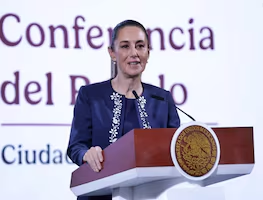Más Información

“En algunos años habrá una secretaria de la Defensa”, afirma subdirectora de la Escuela Militar de Medicina

Claudia Sheinbaum, por definir asistencia presencial a reunión "urgente" de la Celac; migración, tema clave del encuentro

Noroña califica política de EU como hipócrita, racista y fascista; se solidariza con Petro ante deportaciones

Magistrada Mónica Soto propone sustituir al Comité de Evaluación del PJ; plantea someter a insaculación a aspirantes elegibles

Magistrado Reyes Rodríguez propone validar registros de aspirantes con promedio inferior a 8; excluirlos es “estigmatizante”, señala
Mexican territory has not always been the same. Its borders have expanded and contracted due to political and natural reasons, like the time Bravo River changed its flow in advantage of the U.S. or when Yucatán seek its independence in 1841 and 1846.
But losing an island in a trial held on the other side of the world while Mexico lived the consequences of war is an anecdote that has been researched during decades.
The Pacific Ocean, 1897
. Approximately 1,200 kilometers away from Acapulco is Clipperton island , also known as Medano or La Pasión island. Its abundance of guano (bird droppings highly appreciated for their fertilizing properties) make it attractive for foreign capital.
Stories from the previous century describe it as a deserted island, surrounded by numerous fish and sharks, with no vegetation , that barely rose 10 feet over sea level , flooded in rainy season, for inside it there is a big lake of non-potable water .
It is known that the place was discovered in November 1527 by Spanish Álvaro de Saavedra Cedrón in a mission ordered by Hernán Cortés to find a new route to arrive at the Philippines.
Saavedra wrote down the even in his logbook and later, with the declaration of independence, the land was left in Mexico’s hands.
Nevertheless, he was not the only sailor who saw it. Others passed by it and named it Medano or La Pasión island. The piece of land was still there, without anyone giving it great attention and it only worked as a point of reference to sail.
Its abundant resources were still unknown. In 1705 , the English pirate John Clipperton saw the island during one of his travels and, since then, it was known by his European last name, but his country could not claim it as theirs because of Clipperton’s legal situation.
Thus the years passed by until 1858 , when France declared the island belonged to it since one of its vessels had arrived at it. However, they did not leave any signals of settling or periodical visits , as mentioned by Professor Laura Ortiz Valdez from the National Autonomous University of Mexico (UNAM).
It is true that they wanted to exploit the island’s guano to sell it as fertilizer , but owning Clipperton would also give them a strategic advantage over the Panama Canal.
Over time, the French had practically forgotten about the island and they did little to explore it. Problems started when a ship passed near the island and the crew noticed there was a United Kingdom flag.
They immediately informed the news about it. The news arrived in Mexico , and the government sent an expedition to inspect it and ask the foreigners to vacate the island .
Nonetheless, there were some negotiations and Mexico received tax payments for the conferment for guano exploitation from the U.K.
When the French government knew Mexico had claimed the island in due right, they argued that they were the first to discover it and a diplomatic confrontation began.
“France and Mexico started to fight for the island in 1897 . France based its rights on one of its vessels, looking for guano, arriving at the island in November of that year and flew the flag with the colors of Napoleon III, informing France’s Foreign Affairs office of what it had done,” says an article published by EL UNIVERSAL .
The countries did not reach an agreement and they posed to bring the issue to a neutral international court that would decide who owned the island. In 1909 , it was decided that the judge would be Victor Manuel III, king of Italy .
They asked for a hasty decision from him, but the trial lasted for 22 years . Meanwhile, the government of Porfirio Díaz sent a thousand military men to Clipperton and, later, a family, to be present on the island.
The place was inhospitable, impossible for agriculture, and drinking water was obtained from rainfall. Every three months, the government sent the settlers a s hip full of food that took up to four days to arrive at the island.
Ignoring the situation in Mexico, a day in 1912 they noticed the ship had taken longer than usual to arrive. With the Mexican Revolution , that started in 1910 , the journeys stopped and the case was forgotten for years.
Malnourished and worse attired, they survived until their rescue in July 1917 by a ship that took them to Salina Cruz . Only some women and children survived. There is a hypothesis that suggests they practiced cannibalism when provisions became scarce.
In Europe, far away from this situation, a king’s servant presented himself in Paris with the decision of king Victor Manuel III. It was 1931 . “Even the oldest employees of the Foreign Affairs office had completely forgotten of the matter and it was necessary to look hastily in the archives,” reported EL UNIVERSAL .
Although the Mexican government presented maps, ship’s logbooks , and other evidence that the island had been discovered by the Spanish and later “inherited” by independent Mexico, the decision was unquestionable.
That same night, orders were sent by telegraph to fly, once again, the French flag in Clipperton Island. “Even though it seems strange, the French feel prouder of this small islet than of any other recent colonial acquisition,” says an article by EL UNIVERSAL published in 1931 .
Then then- Minister of Foreign Affairs Genaro Estrada declared to news outlets that the Mexican government decided to reserve it right to examine in detail the decision.
Hence, with the reform to article 42 of the Constitution, the island stopped being part of Mexican territory and the agreement was made effective on January 18, 1934, without Mexico’s appeal.
Although this event did not have any influence in Mexico to be more careful with its territory, during the 1980s it was necessary to make an inventory of the islands, cays, and islets in national territory.
The task was in charge of Don Máximo Evia , who used to be a public officer from the government. He went through all Mexican coasts, from the Baja California peninsula, to Chiapas and Quintana Roo, to finally conclude in Tamaulipas.
He concluded that Mexico has 239 islands, 23 cayes, and 20 reefs . In addition, he made exhaustive research about the legal situation of each territory, all of it registered in the catalog.
Although Don Máximo did not study Clipperton since it was not part of Mexican territory, he knows deeply the story of the island.
“The biggest mistake was not to set a date for the arbitration. Even though time was not specified, it is not possible that after so many years, when Italy was already an ally of the Axis Powers , the decision on Clipperton was taken,” he thinks.
According to a UNAM article published in 2010 , one of the most outstanding offshore resources of Clipperton island are the Manganese nodules that contain layers of iron, manganese, nickel, cobalt, and copper.
These metals are found from 3,000 to 4,000 meters deep and reveal information on marine geology , but they are also highly demanded in the aerospace industry.
Manganese nodules are used to build highly heat-resistant iron structures , useful qualities for the construction of planes, submarines, and spaceships.
In recent years, several French research groups and news outlets have reported the pollution in the deserted island due to plastic. There is also evidence of weapons remains from the Second World War.
Although Clipperton’s fishing and metallic resources are useful for different industries and scientific expeditions that study the area, the island that was once a reason for dispute is now polluted.
mp













